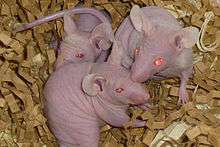BALB/c

BALB/c is an albino, laboratory-bred strain of the House Mouse from which a number of common substrains are derived. Now over 200 generations from New York in 1920, BALB/c mice are distributed globally, and are among the most widely used inbred strains used in animal experimentation.[1]
History
The founding animals of the strain were obtained by Halsey J. Bagg of Memorial Hospital, New York, from a mouse dealer in Ohio in 1913. From 1920, the progeny of the original colony were systematically inbred, sibling to sibling, for 26 generations over 15 years. During this time, the colony passed through the care of a number of scientists, including C.C. Little and E.C. MacDowell at the Carnegie Institution of Washington and H.J. Muller at the University of Texas.[2] By 1935 the animals were in the possession of Muller's student, George Davis Snell, who moved them to The Jackson Laboratory. This stock provided the basis of all the BALB/c substrains that are now in use around the world.[3]
Snell provided some animals from this stock to the National Institutes of Health (NIH) to maintain. In 1961 D. W. Bailey used some of these to generate a substrain at the University of California, San Francisco. In 1974, now 136 generations from the original breeding pair, these animals were returned to The Jackson Laboratory and were named BALB/cByJ.[3] On 16 November 2005, The Jackson Laboratory reported this substrain had reached its 235th generation.[4]
Snell also provided a colleague, J. Paul Scott, with some BALB/c breeding stock in 1938 or 1939.[2] When a fire destroyed the main Jackson Laboratory buildings in 1947,[5] all of Snell's original breeding stock perished, but Scott's mice were in a different building and survived. Scott donated stock back, at generation 41, to repopulate the colony. The progeny of these are now termed BALB/cJ and, as of 14 December 2006, were 221 generations from the founding stock.[6] Other less popular substrains, such as BALB/cWt, are maintained at the Jackson Laboratory, while the BALB/cN substrain is maintained by the NIH.[3]
Characteristics

BALB/c mice are useful for research into both cancer and immunology. According to Michael Festing's Inbred Strains of Mice,[1] BALB/c substrains are "particularly well known for the production of plasmacytomas on injection with mineral oil," an important process for the production of monoclonal antibodies. They are also reported as having a "low mammary tumour incidence,[1] but do develop other types of cancers in later life, most commonly reticular neoplasms, lung tumours, and renal tumours.[4][6] Most substrains have a "long reproductive life-span",[1] are noted for displaying high levels of anxiety and for being relatively resistant to diet-induced atherosclerosis, making them a useful model for cardiovascular research.[4][6]
There are noted differences between different BALB/c substrains, though these are thought to be due to mutation rather than genetic contamination.[7] For example, male BALB/c mice are aggressive and will fight other males if housed together. However, the BALB/Lac substrain is much more docile.[8] The BALB/cWt is also unusual in that 3% of progeny display true hermaphroditism.[9]
See also
External links
References
| Wikimedia Commons has media related to Inbred BALB C mice. |
- 1 2 3 4 "BALB/c". Inbred Strains of Mice. Jackson Laboratory. Retrieved 2007-04-16.
- 1 2 Potter M. History of the BALB/c family, pp 1-5. In: The BALB/c Mouse: Genetics and Immunology, Current Topics in Microbiology and Immunology, Vol. 122. Springer-Verlag, NY. 1985.
- 1 2 3 "A Brief History of the Two Substrains of BALB/c, BALB/cJ, and BALB/cByJ". Jax Mice Literature. Jackson Laboratory. Retrieved 2010-09-30.
- 1 2 3 "BALB/cByJ". Jax Mice Data Sheet. Jackson Laboratory. Archived from the original on 16 November 2006. Retrieved 2007-04-16.
- ↑ "The Jackson Laboratory Milestones: 1940 - 1949". The Jackson Laboratory Timeline. Jackson Laboratory. Archived from the original on 15 September 2007. Retrieved 2007-04-16.
- 1 2 3 "BALB/cJ". Jax Mice Data Sheet. Jackson Laboratory. Archived from the original on 11 April 2007. Retrieved 2007-04-16.
- ↑ Hilgers J., van Nie R., Ivanyi D., Hilkens J., Michalides R., de Moes J., Poort-Keesom R., Kroezen V., von Deimling O., Kominami R., and Holmes R. (1985) Genetic differences in BALB/c sublines. Curr. Top. Microbiol. Immunol. 122, 19-30.
- ↑ Southwick C. H. and Clark L. H. (1966) Aggressive behaviour and exploratory activity in fourteen mouse strains. Am. Zool. 6, 559.
- ↑ Eicher E. M., Beamer W. G., Washburn L. L., and Whitten W. K. (1980) A cytogenetic investigation of inherited true hermaphroditism in BALB/cWt mice. Cytogenet. Cell Genet. 28, 104-115.
